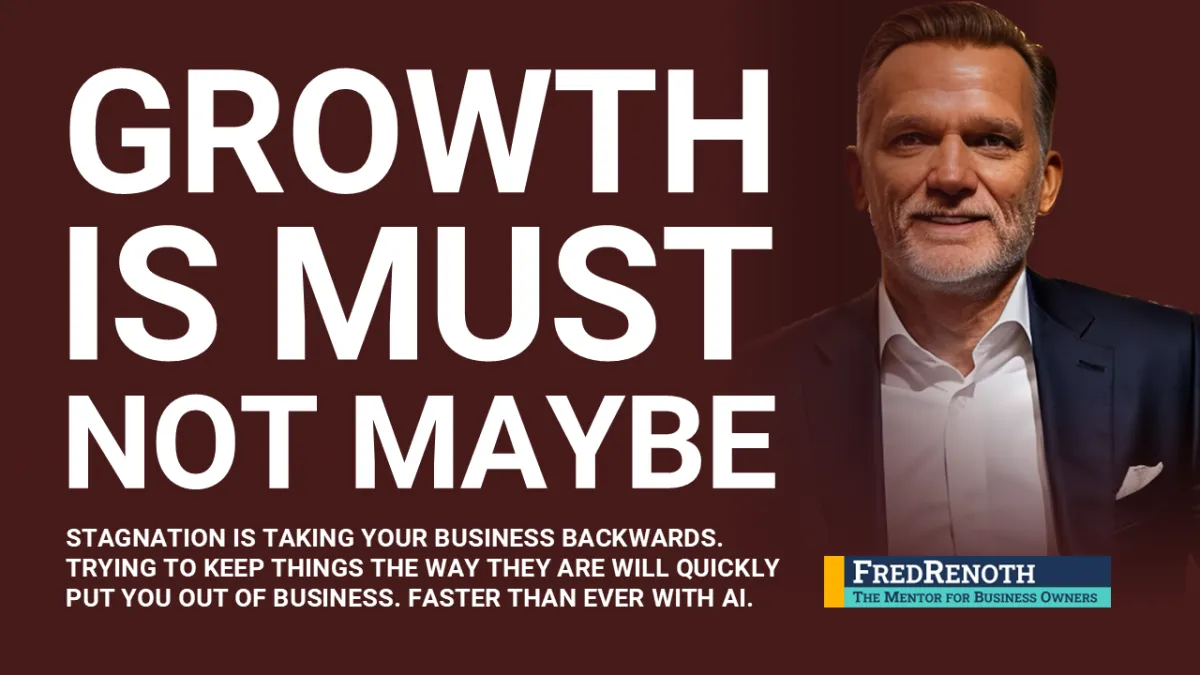


Welcome to Fred's
the Healthy Business BLOG

Why Business Growth Is Essential: The Hidden Risks of Standing Still
There was a small Italian restaurant on the outskirts of Chicago called Romano's. It had been in the family for two generations, serving up homemade pasta and rustic pizzas that the locals absolutely loved. Marco Romano, the owner, loved his work. He had a solid team, regulars who were like family, and he was making enough money to live comfortably.
One evening, while doing the books, Marco noticed something strange. The numbers weren't as strong as they used to be. His ingredients were costing more, his rent had gone up, and his staff was asking for raises. But his daily revenue hadn't changed. He let out a sigh, leaned back in his chair, and muttered to himself, "Why should I grow? I have everything I need."
But Marco didn't see that staying still was already putting him in danger.
His competitors were running online promos and teaming up with food delivery apps. There was this cool new Italian place that opened down the street, serving up trendy takes on classic dishes. Younger crowds were being drawn in by all the hype on social media. Meanwhile, Romano's was stuck the same, year after year.
It wasn't long before the empty tables started to stand out. Regular customers, who used to fill the restaurant on weekends, started going elsewhere. His best sous chef left for a job with better pay. The costs of running the restaurant kept going up, but the money coming in didn't. Marco finally decided to do something about it, but it was too late.
The Illusion of Stability
A lot of business owners, like Marco, think that if their company is making money, they don't need to grow. They think that keeping things as they are is a safe bet.
But the truth is, staying still in business is actually moving backward.
Expenses always keep going up. Inflation makes supplies, rent, and wages more expensive. Employees want better pay and benefits. Competitors are always coming up with new ideas, offering more services, and finding new customers. Technology changes how people do business. The market keeps changing, and customer expectations keep shifting.
A business that doesn’t grow doesn’t just stay the same - it slowly loses its position.
And here’s the brutal truth: If you don’t make your business better, stronger, and more adaptable, you won’t even realize you’re in trouble until the warning signs turn into a crisis.
Companies That Ignored Growth and Paid the Price
History is full of businesses that refused to grow or adapt - and as a result, they disappeared.
Blockbuster is a good example. Blockbuster was the king of movie rentals, but they could've easily embraced streaming services. They even had the chance to buy Netflix in its early days, but they turned it down. Why? They were just too comfortable. They didn't see the need to evolve or adapt. We all know what happened next—Netflix took over the market, and Blockbuster went under.
And let's not forget Kodak. They invented the digital camera but refused to push it forward, fearing it would hurt their film business. By the time they figured out that digital was the way of the future, companies like Canon and Sony had already taken over. Kodak went bankrupt.
And let's not forget Toys "R" Us, a company that dominated the toy industry for decades. They ignored e-commerce and stuck to their traditional retail stores, while Amazon and Walmart took over online toy sales. By the time Toys "R" Us tried to catch up, it was too late.
The Businesses That Grew and Thrived
But companies that get how important it is to grow don't just survive — they thrive.
Amazon started as an online bookstore, but they've constantly evolved, expanding into electronics, cloud computing, and even groceries. Now, they're one of the most valuable companies on the planet.
Apple didn't just stop at making computers. They innovated with the iPod, then the iPhone, then the App Store, and now they're a global technology leader. Each move was a step toward continuous growth and reinvention.Even McDonald's, a company that could have stayed a simple fast-food chain, understood the importance of growth. They introduced breakfast menus, international menu items, mobile ordering, and even healthier options to adapt to changing customer preferences. That's why they're still the biggest fast-food brand in the world.
Why Growth Is Inevitable
If a business wants to stick around, it's gotta grow.
It's the only way to keep up with rising costs. Everything gets more expensive over time—supplies, wages, rent. If your revenue isn't growing, your profit margins will shrink until there's nothing left.
Second, customers are always looking for something new. They want better products, more convenience, and better service. If your business isn't evolving, they'll move on to one that is.
And technology is changing the way business is done. If you're not using new tools like automation, online ordering, or digital marketing, you're going to fall behind.
And finally, your competitors are growing. Even if you think your business is doing well, someone else is working on a way to do it better, faster, or cheaper. If you're not reaching more customers, getting more efficient, or offering more value, your competition is probably going to pass you by.
How to Grow Without Losing Control
Some business owners are afraid of growing because they're worried about losing what makes their business special.
They're afraid that growing will make their business too complicated. They're afraid that bigger means losing control or having to compromise on quality.
But smart growth isn't just about getting bigger — it's about getting better.
It starts by taking a look at your finances — your profit and loss statements should be your best friend. If you understand where your money is going, which expenses are growing, and how your revenue is trending, you can make informed decisions.
Then, focus on your customers — what do they want more of? What are their frustrations? If you can find ways to serve them better, that's the foundation of sustainable growth.
Innovation is key. Take a look at your business model and ask, "What can I improve? Where can I add value?" Sometimes, small improvements — like adding online booking for appointments, offering a new product line, or streamlining operations — can lead to massive growth.
Technology is another game-changer. Companies that embrace automation, artificial intelligence, or data-driven decision-making are always ahead of those that resist change.
Finally, think partnerships, not just competition. Collaborations can help you grow faster than trying to do everything alone.
Action Plan for Growth
To secure long-term success, business owners should take action in five areas:
Keep an eye on your finances regularly - Checking your profit and loss statements can help you spot trends and potential problems before they become major headaches.
Know what the market's up to – Keeping an eye on shifts in customer behavior and industry developments helps businesses stay ahead of the competition.
Improve Efficiency – Finding ways to reduce waste and streamline operations ensures that growth is both profitable and manageable.
Adopt New Technology – Whether it's e-commerce, automation, or AI-driven marketing, using the right tools can dramatically improve business performance.
Expand Strategically – Just because your business is growing doesn't mean you have to open new locations. It could mean improving services, offering new products, or entering new customer segments.
Conclusion
As a business owner, you've got two options: grow or decline.
There's no in between. The businesses that adapt, innovate, and expand are the ones that succeed. The ones that don't grow are the ones that go out of business.
If Marco Romano had gotten that, he wouldn't have watched his restaurant empty out. If Blockbuster had gotten with the program and embraced change, it might still be a big deal today. And Apple wouldn't be the tech giant it is today if it had stopped innovating.
Want to Take it a Step Further?
Enjoyed this article?
It may give you a taste of what we talk about with our clients in the FredRenoth Mentoring Program.
Check out our website (CLICK HERE FOR WEBSITE).
And, of course, I'm ready to answer all your questions in a Value Call. Just click the button below.
Like What you Read?
Get my weekly updates sent straight to your inbox. Just CLICK HERE to sign up.
Copyright 2025 Sysbizz LLC - All Rights Reserved
















